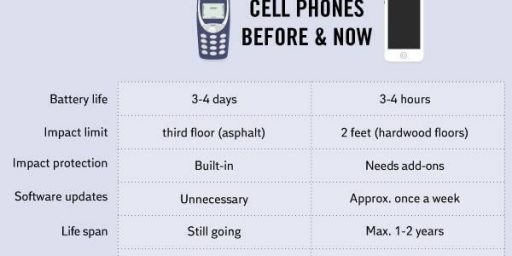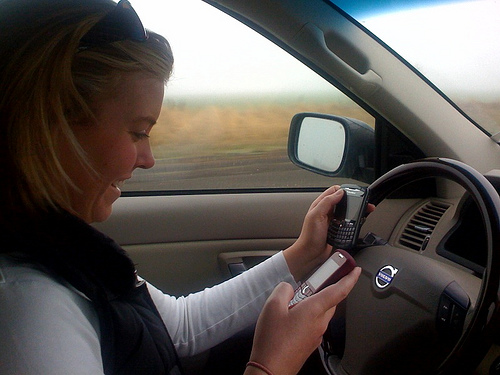Drivers on Cell Phones Slower than Geezers and Drunks
Drivers on Cell Phones Kill Thousands, Snarl Traffic (LiveScience)
Finally, empirical proof you can blame chatty 20-somethings for stop-and-go traffic on the way to work. A new study confirms that the reaction time of cell phone users slows dramatically, increasing the risk of accidents and tying up traffic in general, and when young adults use cell phones while driving, they’re as bad as sleepy septuagenarians. “If you put a 20-year-old driver behind the wheel with a cell phone, their reaction times are the same as a 70-year-old driver who is not using a cell phone,” said University of Utah psychology professor David Strayer. “It’s like instantly aging a large number of drivers.” The study was announced today and is detailed in winter issue of the quarterly journal Human Factors.
Cell phone distraction causes 2,600 deaths and 330,000 injuries in the United States every year, according to the journal’s publisher, the Human Factors and Ergonomics Society. The reason is now obvious: Drivers talking on cell phones were 18 percent slower to react to brake lights, the new study found. In a minor bright note, they also kept a 12 percent greater following distance. But they also took 17 percent longer to regain the speed they lost when they braked. That frustrates everyone. “Once drivers on cell phones hit the brakes, it takes them longer to get back into the normal flow of traffic,” Strayer said. “The net result is they are impeding the overall flow of traffic.”
Strayer and his colleagues have been down this road before. In 2001, they found that even hands-free cell phone use distracted drivers. In 2003 they revealed a reason: Drivers look but don’t see, because they’re distracted by the conversation. The scientists also found previously that chatty motorists are less adept than drunken drivers with blood alcohol levels exceeding 0.08.
While it’s intuitively obvious that people chatting on the phone are less attentive, all things being equal, than they’d be if they were paying attention, the magnitude of the difference is surprising. One wonders if the scientists are properly controlling for other variables. Indeed, a look inside their stats makes the results rather dubious:
The estimates of annual deaths reported in this week’s article (2,600) may well be low. The number, for U.S. deaths related to drivers using cell phones, comes from a 2002 study by the Harvard Center for Risk Analysis (HCRA). Researchers then estimated that the use of cell phones by drivers caused approximately 2,600 deaths. Because data on cell phone use by motorists are limited, the range of uncertainty is wide, those researchers said. The estimate of fatalities in that HCRA report ranged between 800 and 8,000.
Any methodology with a range that wide–a factor of ten more or less?!– is worse than worthless. The statistics are spouted and attributed to “scientists” and “experts” when, in fact, the proper answer is “we have no clue whatsoever.”
The estimates are based largely on mathematical models, but they are not without basis. In 2001 in California, for example, “at least 4,699 reported accidents were blamed on drivers using cell phones, and those crashes killed 31 people and injured 2,786,” according to an analysis by The Los Angeles Times. That number can expected to be low, because of the lack of formal procedures for noting cell phone use as a cause of a traffic accident.
Well, no. So, we have 4,699 accidents. Out of how many total? Blamed? By whom? On what basis?
And, finally, we get to the Utah study itself:
Participants in the simulator used dashboard instruments, steering wheel and brake and gas pedals from a Ford Crown Victoria sedan, surrounded by three screens showing freeway scenes and traffic, including a “pace car” that intermittently hit its brakes 32 times as it appeared to drive in front of study participants. If a participant failed to hit their own brakes, they eventually would rear-end the pace car. Each participant drove four simulated 10-mile freeway trips lasting about 10 minutes each, talking on a cell phone with a research assistant during half the trips and driving without talking the other half. Only hands-free phones were used to eliminate any possible distraction from manipulating a hand-held cell phone.
So, they played arcade games? For 10 minutes at a time? And from this they extrapolated to real life driving conditions?






They tried the same argument back in the late 70’s and early 80’s with CB radios being the big nasty culprit.
Until, that is, that some bright guy noted that CB radios looked and operated pretty much the same way police radios, fire radios and so on do, and wondered aloud if these would be banned as well.
I flew into Detrroit a few years ago on a business trip. I arrived late and drove south from the airport on the freeway. Not much traffic. The guy out in front of me is slowing down and slowing down and slowing down. When we got to thirty five I figured I ought to see what was out in front of him causing the problem before traffic did come up fast from behind me. I signalled, changed lanes, and looked ahead. There was nothing there ahead of this guy. WTF? As I passed him I looked over and saw he was engaged in a very animated conversation on his cell phone.
Bickering about cell phone use behind the wheel is a waste of “ink.” The most effective killer of American children is the American driver. [reference here] Been that way for years — for decades — but who’s doing anything about it? Just look at how cars are advertised, look at how televised NASCAR is promoted, just look at how people drive, just look at how YOU drive. It is America’s biggest, broadest, and deadliest cultural “blind spot.” Last Sunday, more people where killed by drivers in the U.S. than by terrorists in Iraq. About 3,000 died on 9/11, and the U.S. has since invaded two countries. By 10/11 we had killed more than 3,000 with our cars, and nothing has been done about the homegrown “nut behind the wheel.” Cell phones and traffic safety? Come back when your serious.
If you put a 20-year-old driver behind the wheel with a cell phone, their reaction times are the same as a 70-year-old driver who is not using a cell phone,
More appropriately their (the 20 something) reactions are are akin to a 70-year-old that is trying to program a DVD player.